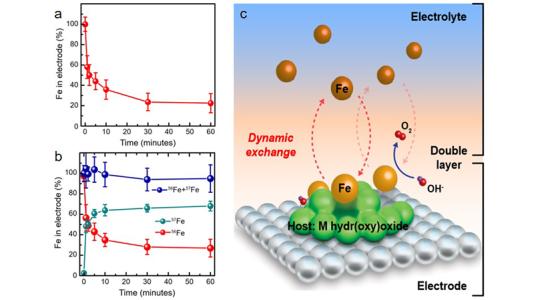
Scientific Achievement
Dynamically stable iron (Fe), as a result of dissolution and redeposition at the electrolyte/host interface, provides a general description for O2 evolution activity and stability.
Significance and Impact
Dynamic stability overcomes the limitations imposed by the thermodynamic instability of oxide materials and demonstrates new concepts of “stability”.
Research Details
- Design of a new (electro)chemical interface was validated by an active site/host pair using a well controlled hydr(oxy)oxide cluster.
- In situ and ex situ ICP-MS, in combination with isotope labeling, confirm dynamic exchange of Fe active sites.
Argonne National Laboratory seeks solutions to pressing national problems in science and technology. The nation’s first national laboratory, Argonne conducts leading-edge basic and applied scientific research in virtually every scientific discipline. Argonne researchers work closely with researchers from hundreds of companies, universities, and federal, state and municipal agencies to help them solve their specific problems, advance America’s scientific leadership and prepare the nation for a better future. With employees from more than 60 nations, Argonne is managed by UChicago Argonne, LLC for the U.S. Department of Energy’s Office of Science.
The U.S. Department of Energy’s Office of Science is the single largest supporter of basic research in the physical sciences in the United States and is working to address some of the most pressing challenges of our time. For more information, visit https://energy.gov/science.